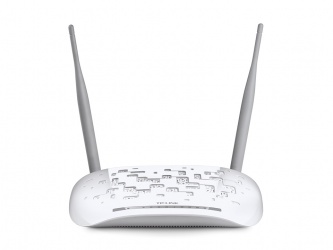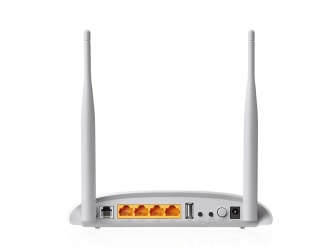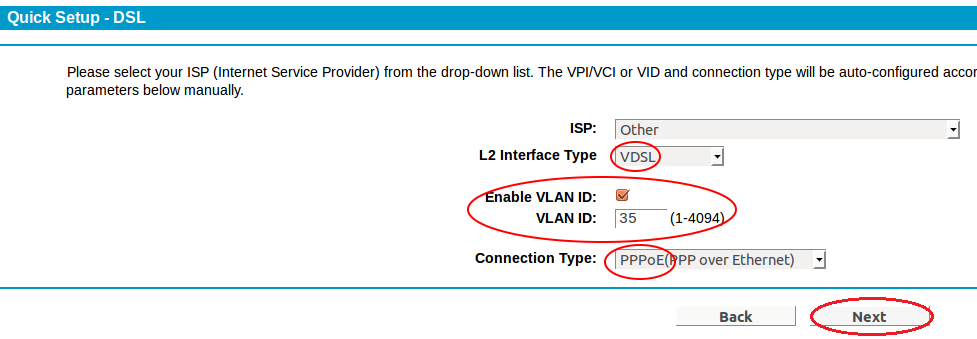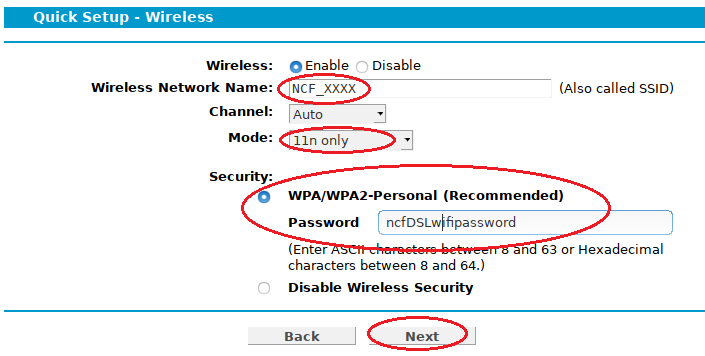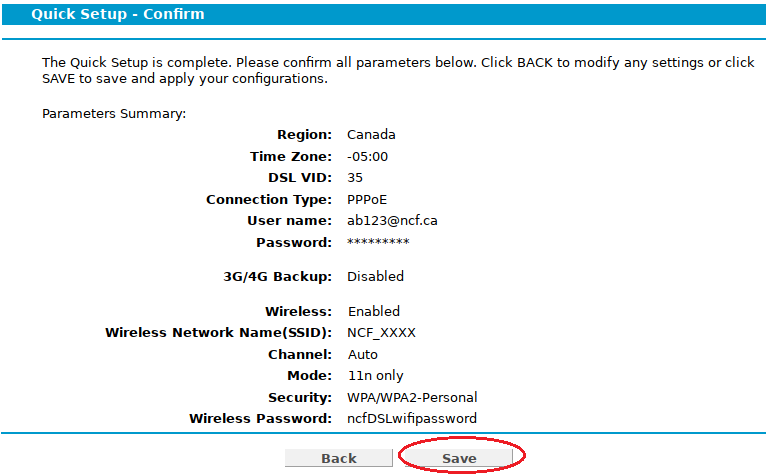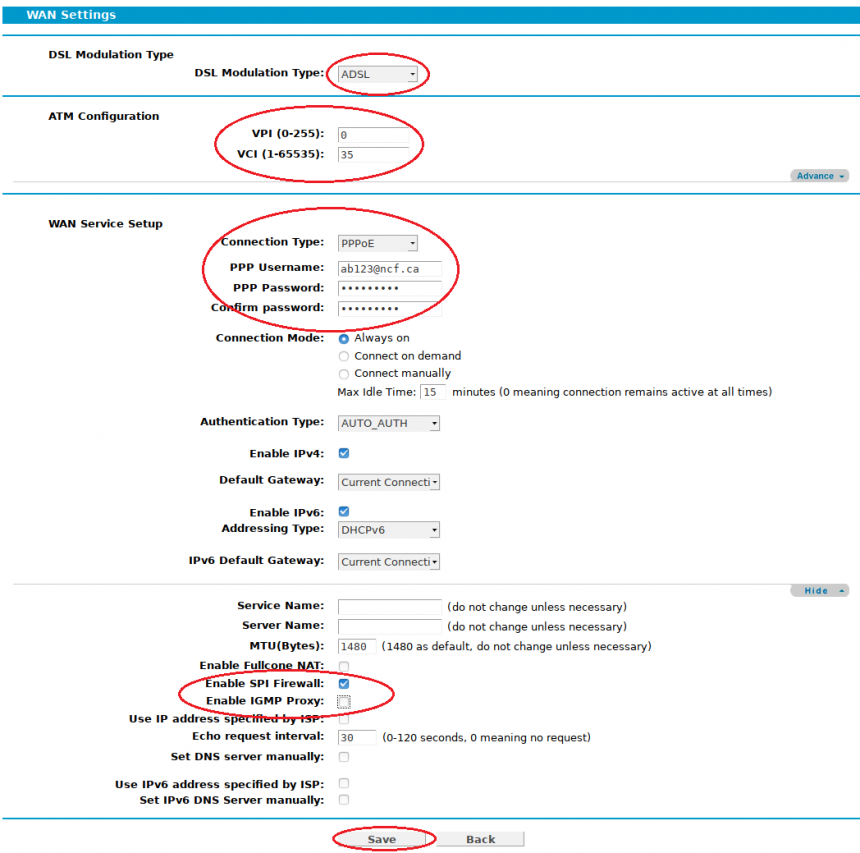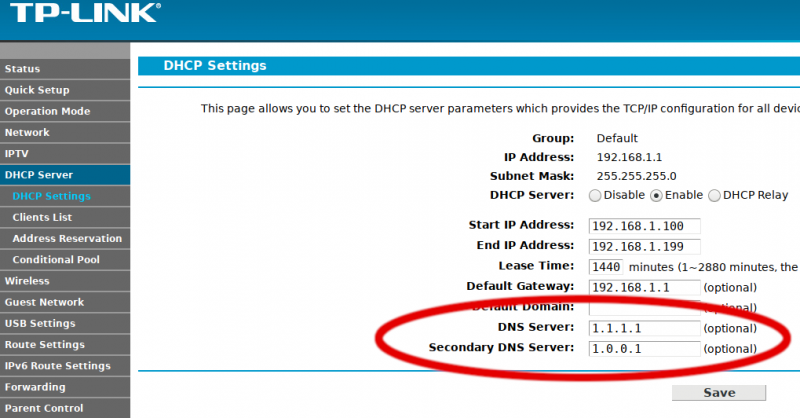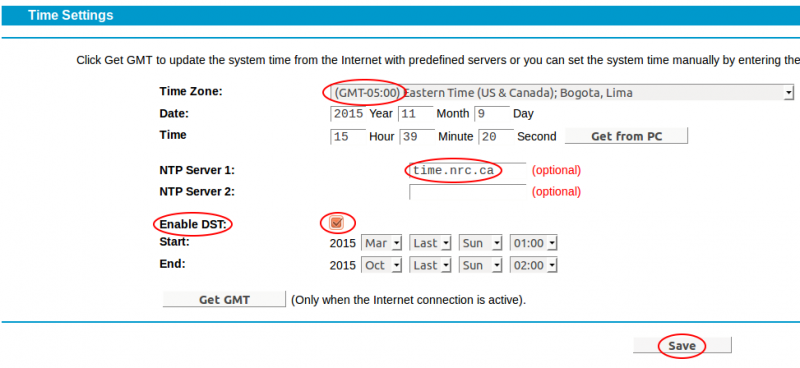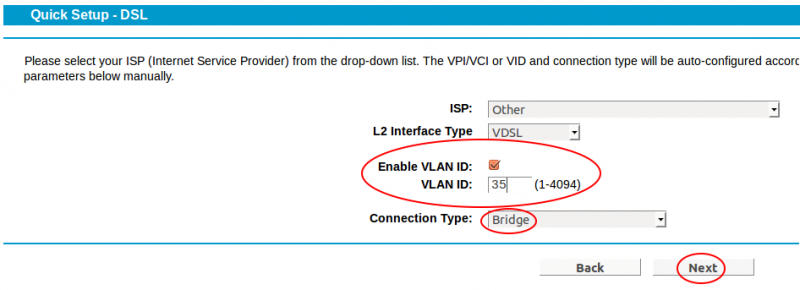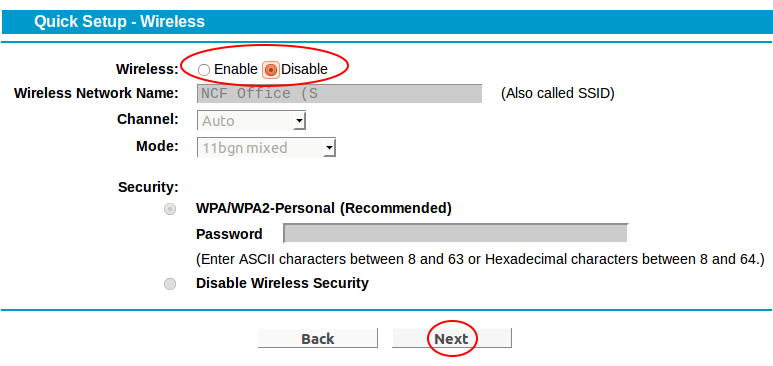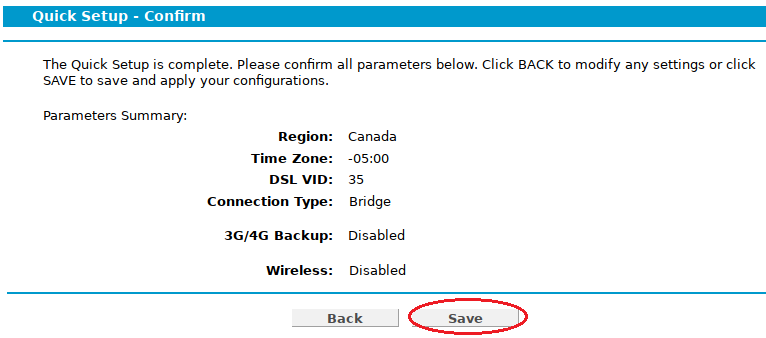Difference between revisions of "TP-Link TD-W9970 Configuration"
m |
m |
||
| Line 1: | Line 1: | ||
<div class="ncfrightbox"> {{Template:Modem Links}} </div> | <div class="ncfrightbox"> {{Template:Modem Links}} </div> | ||
TD-W9970_Links | |||
[[File:TD-W9970_front.jpg|thumb|left|x250px|The TP-Link TD-W9970 Modem Front]] | [[File:TD-W9970_front.jpg|thumb|left|x250px|The TP-Link TD-W9970 Modem Front]] | ||
[[File:TD-W9970_back.jpg|thumb|left|x250px|The TP-Link TD-W9970 Modem Back]] | [[File:TD-W9970_back.jpg|thumb|left|x250px|The TP-Link TD-W9970 Modem Back]] | ||
| Line 5: | Line 6: | ||
=Routed= | =Routed= | ||
{{Template:TD-W9970_Links}} | |||
The TP-Link TD-W9970 modem router supports both ADSL and VDSL, and switches automatically to match the line it is connected to. | The TP-Link TD-W9970 modem router supports both ADSL and VDSL, and switches automatically to match the line it is connected to. | ||
==VDSL== | ==VDSL== | ||
{{Template:TD-W9970_Links}} | |||
We will start with the mode used for VDSL connections. These include the following NCF DSL Plans: | We will start with the mode used for VDSL connections. These include the following NCF DSL Plans: | ||
* Freedom 10-7/Unl | * Freedom 10-7/Unl | ||
| Line 14: | Line 19: | ||
* Freedom 50/Unl | * Freedom 50/Unl | ||
'''Quick Setup''' | '''Quick Setup''' | ||
'''NOTE:''' If the modem is brand new, "user name: admin" and "password: admin" will gain access. | '''NOTE:''' If the modem is brand new, "user name: admin" and "password: admin" will gain access. | ||
| Line 25: | Line 30: | ||
[[file:Td-w9970_setup1.png|1050x1050px|Getting started]] | [[file:Td-w9970_setup1.png|1050x1050px|Getting started]] | ||
'''Region and Time Zone'''{{Template: | |||
'''Region and Time Zone''' | |||
{{Template:Back to the Top}} | |||
# Set Region to '''Canada''' | # Set Region to '''Canada''' | ||
| Line 33: | Line 41: | ||
[[file:Td-w9970_setup2.png|1121x1121px|Step2]] | [[file:Td-w9970_setup2.png|1121x1121px|Step2]] | ||
'''Auto Detection'''{{Template: | '''Auto Detection''' | ||
{{Template:Back to the Top}} | |||
# Click on '''No, I want to configure The Internet Connection myself''' | # Click on '''No, I want to configure The Internet Connection myself''' | ||
| Line 40: | Line 50: | ||
[[file:Td-w9970_setup3.png|1012x1012px|Step3]] | [[file:Td-w9970_setup3.png|1012x1012px|Step3]] | ||
'''DSL'''{{Template: | '''DSL''' | ||
{{Template:Back to the Top}} | |||
# ISP: '''Other''' | # ISP: '''Other''' | ||
| Line 51: | Line 63: | ||
[[file:Td-w9970_setup4.png|1009x1009px|Step4]] | [[file:Td-w9970_setup4.png|1009x1009px|Step4]] | ||
'''PPPoE'''{{Template: | '''PPPoE''' | ||
{{Template:Back to the Top}} | |||
# User name: '''ab123@ncf.ca''' (where ab123 is your NCF ID) | # User name: '''ab123@ncf.ca''' (where ab123 is your NCF ID) | ||
| Line 60: | Line 74: | ||
[[file:Td-w9970_setup5.png|974x974px|Step5]] | [[file:Td-w9970_setup5.png|974x974px|Step5]] | ||
'''3G/4G'''{{Template: | '''3G/4G''' | ||
{{Template:Back to the Top}} | |||
# Click '''Next''' | # Click '''Next''' | ||
| Line 66: | Line 82: | ||
[[file:Td-w9970_setup6.png|970x970px|Step6]] | [[file:Td-w9970_setup6.png|970x970px|Step6]] | ||
'''Wireless'''{{Template: | '''Wireless''' | ||
{{Template:Back to the Top}} | |||
# Wireless: '''Enable''' | # Wireless: '''Enable''' | ||
| Line 78: | Line 96: | ||
[[file:Td-w9970_setup7.png|947x947px|Step7]] | [[file:Td-w9970_setup7.png|947x947px|Step7]] | ||
'''Confirm'''{{Template: | '''Confirm''' | ||
{{Template:Back to the Top}} | |||
# Verify all setting are as entered | # Verify all setting are as entered | ||
| Line 85: | Line 105: | ||
[[file:Td-w9970_setup8.png|961x961px|Step8]] | [[file:Td-w9970_setup8.png|961x961px|Step8]] | ||
'''Complete'''{{Template: | '''Complete''' | ||
{{Template:Back to the Top}} | |||
# Click '''Finish''' | # Click '''Finish''' | ||
| Line 96: | Line 118: | ||
# Click on '''Action: Edit''' (entry with pppoe_ptm_35_1_d, right-hand side of table) | # Click on '''Action: Edit''' (entry with pppoe_ptm_35_1_d, right-hand side of table) | ||
'''WAN Settings'''{{Template: | '''WAN Settings''' | ||
{{Template:Back to the Top}} | |||
# WAN Service Setup, enter... | # WAN Service Setup, enter... | ||
| Line 106: | Line 130: | ||
== ADSL == | == ADSL == | ||
{{Template:TD-W9970_Links}} | |||
Moving on now to add settings for ADSL. ADSL is required for the following NCF DSL Plans: | Moving on now to add settings for ADSL. ADSL is required for the following NCF DSL Plans: | ||
* Freedom 6/300 | * Freedom 6/300 | ||
| Line 115: | Line 141: | ||
# Click '''WAN Settings''' | # Click '''WAN Settings''' | ||
'''DSL WAN Interface'''{{Template: | '''DSL WAN Interface''' | ||
{{Template:Back to the Top}} | |||
# Click on '''Action: Delete''' (1st entry, right-hand side of table) | # Click on '''Action: Delete''' (1st entry, right-hand side of table) | ||
| Line 123: | Line 151: | ||
'''WAN Settings''' | '''WAN Settings''' | ||
{{Template: | |||
{{Template:Back to the Top}} | |||
# DSL Modulation Type: '''ADSL''' | # DSL Modulation Type: '''ADSL''' | ||
# ATM Configuration: '''VPI/VCI = 0/35''' | # ATM Configuration: '''VPI/VCI = 0/35''' | ||
| Line 141: | Line 171: | ||
== DNS Fix == | == DNS Fix == | ||
{{Template: | {{Template:TD-W9970_Links}} | ||
There is a known issue where the internal DNS server sometimes stop responding after swapping between ADSL and VDSL connections. To avoid this issue, we recommend hard-coding a public DNS server instead of using the internal one. | There is a known issue where the internal DNS server sometimes stop responding after swapping between ADSL and VDSL connections. To avoid this issue, we recommend hard-coding a public DNS server instead of using the internal one. | ||
| Line 152: | Line 182: | ||
== UPnP == | == UPnP == | ||
{{Template: | {{Template:TD-W9970_Links}} | ||
# Click on '''Forwarding''' (left-hand menu, near the middle) | # Click on '''Forwarding''' (left-hand menu, near the middle) | ||
# UPnP: '''de-select''' | # UPnP: '''de-select''' | ||
| Line 158: | Line 189: | ||
== Time == | == Time == | ||
{{Template: | {{Template:TD-W9970_Links}} | ||
# Click on '''System Tools''' (left-hand menu, towards the bottom) | # Click on '''System Tools''' (left-hand menu, towards the bottom) | ||
| Line 172: | Line 203: | ||
== Manage Control== | == Manage Control== | ||
{{Template: | {{Template:TD-W9970_Links}} | ||
# Click on '''System Tools''' (left-hand menu, towards the bottom) | # Click on '''System Tools''' (left-hand menu, towards the bottom) | ||
| Line 184: | Line 215: | ||
== CWMP == | == CWMP == | ||
{{Template:TD-W9970_Links}} | |||
# Click on '''System Tools''' (left-hand menu, towards the bottom) | # Click on '''System Tools''' (left-hand menu, towards the bottom) | ||
# Select '''CWMP Settings''' | # Select '''CWMP Settings''' | ||
| Line 191: | Line 224: | ||
==Firewall== | ==Firewall== | ||
{{Template: | {{Template:TD-W9970_Links}} | ||
# Click '''Firewall''' in the left column | # Click '''Firewall''' in the left column | ||
| Line 197: | Line 230: | ||
=Bridge= | =Bridge= | ||
{{Template: | {{Template:TD-W9970_Links}} | ||
Do this only if you prefer to use your own external router rather than the one built into your TP-Link unit. | Do this only if you prefer to use your own external router rather than the one built into your TP-Link unit. | ||
| Line 211: | Line 244: | ||
==VDSL== | ==VDSL== | ||
{{Template: | {{Template:TD-W9970_Links}} | ||
# Click on '''Quick Setup'''. | # Click on '''Quick Setup'''. | ||
'''DSL''' | '''DSL''' | ||
{{Template:Back to the Top}} | |||
# ISP: '''Other''' | # ISP: '''Other''' | ||
# L2 Interface Type: '''VDSL''' | # L2 Interface Type: '''VDSL''' | ||
| Line 226: | Line 261: | ||
'''Wireless''' | '''Wireless''' | ||
{{Template: | {{Template:Back to the Top}} | ||
# Wireless: '''Disable''' | # Wireless: '''Disable''' | ||
| Line 234: | Line 269: | ||
'''Confirm''' | '''Confirm''' | ||
{{Template: | {{Template:Back to the Top}} | ||
# Verify all setting are as entered | # Verify all setting are as entered | ||
| Line 245: | Line 280: | ||
# Click '''WAN Settings''' | # Click '''WAN Settings''' | ||
# On the '''DSL WAN Interface''' page click '''Add''' | # On the '''DSL WAN Interface''' page click '''Add''' | ||
==ADSL== | ==ADSL== | ||
'''WAN Settings''' | {{Template:TD-W9970_Links}} | ||
'''WAN Settings''' | |||
# DSL Modulation Type: select '''ADSL''' | # DSL Modulation Type: select '''ADSL''' | ||
# ATM Configuration, enter... | # ATM Configuration, enter... | ||
| Line 260: | Line 298: | ||
= See Also = | = See Also = | ||
{{Template: | {{Template:TD-W9970_Links}} | ||
*[[Modem Configuration]] - for a complete list of instructions for all NCF modems | *[[Modem Configuration]] - for a complete list of instructions for all NCF modems | ||
Revision as of 15:40, 22 February 2019
TD-W9970_Links
The TP-Link TD-W9970 is for use on any service on networks using Bells' DSL infrastructure. To learn more about configuring your particular modem, consult the manual.
Routed
Routed | VDSL | ADSL | DNS Fix | UPnP | Time | Manage Control | CWMP | Firewall ♦ Bridge | VDSL | ADSL ♦ See Also
The TP-Link TD-W9970 modem router supports both ADSL and VDSL, and switches automatically to match the line it is connected to.
VDSL
Routed | VDSL | ADSL | DNS Fix | UPnP | Time | Manage Control | CWMP | Firewall ♦ Bridge | VDSL | ADSL ♦ See Also
We will start with the mode used for VDSL connections. These include the following NCF DSL Plans:
- Freedom 10-7/Unl
- Freedom 15-10/Unl
- Freedom 25/Unl
- Freedom 50/Unl
Quick Setup
NOTE: If the modem is brand new, "user name: admin" and "password: admin" will gain access.
If the modem is not new, it is recommended to reset the modem to the factory defaults by holding down the Reset/Wi-Fi button for 6 to 9 seconds and then do step 1.
1. Once you access the modem from your browser at http://192.168.1.1 and login (user name: admin and password: admin), click the Quick Setup link in the Menu on the left.
Then click Next on the Quick Setup-Start page.
Region and Time Zone
- Set Region to Canada
- Time Zone to (GMT-05:00) Eastern Time (US & Canada)
- Click Next
Auto Detection
- Click on No, I want to configure The Internet Connection myself
- Click Next
DSL
- ISP: Other
- L2 Interface Type: VDSL
- Enable VLAN ID: checked
- VLAN: 35
- Connection Type: PPPoE
- Click Next
PPPoE
- User name: ab123@ncf.ca (where ab123 is your NCF ID)
- Password: •••••••• (where •••••••• is your NCF DSL Password)
- Confirm password: ••••••••
- Click Next
3G/4G
- Click Next
Wireless
- Wireless: Enable
- Wireless Network Name (SSID): NCF_XXXX (where XXXX are the last 4 digits of the modem serial number)
- Channel: Auto
- Mode: 11n only
- Security: WPA2
- Password: DSL Password
- Click Next
Confirm
- Verify all setting are as entered
- Click Next
Complete
- Click Finish
Stay logged-in
- Click Network (left-hand menu, 4th link from top)
- Click WAN Settings
DSL WAN Interface
- Click on Action: Edit (entry with pppoe_ptm_35_1_d, right-hand side of table)
WAN Settings
- WAN Service Setup, enter...
- Enable IPv6: Select off
- Click Advance
- Enable SPI Firewall: selected
- Enable IGMP Proxy: un-select
- Click Save
ADSL
Routed | VDSL | ADSL | DNS Fix | UPnP | Time | Manage Control | CWMP | Firewall ♦ Bridge | VDSL | ADSL ♦ See Also
Moving on now to add settings for ADSL. ADSL is required for the following NCF DSL Plans:
- Freedom 6/300
- Freedom 7/300
- Freedom 15-1/300
Stay logged-in
- Click Network (left-hand menu, 4th link from top)
- Click WAN Settings
DSL WAN Interface
- Click on Action: Delete (1st entry, right-hand side of table)
- Then click Add button
WAN Settings
- DSL Modulation Type: ADSL
- ATM Configuration: VPI/VCI = 0/35
- WAN Service Setup
- Connection Type: PPPoE
- PPP Username: ab123@ncf.ca (where ab123 is your NCF ID)
- PPP Password: •••••••• (your NCF DSL Password)
- Confirm password: ••••••••
- Enable IPv4: selected
- Enable IPv6: select
- Click Advance
- Enable SPI Firewall: selected
- Enable IGMP Proxy: un-select
- Click Save
DNS Fix
Routed | VDSL | ADSL | DNS Fix | UPnP | Time | Manage Control | CWMP | Firewall ♦ Bridge | VDSL | ADSL ♦ See Also
There is a known issue where the internal DNS server sometimes stop responding after swapping between ADSL and VDSL connections. To avoid this issue, we recommend hard-coding a public DNS server instead of using the internal one.
DHCP Settings
- DNS Server: 1.1.1.1
- Secondary DNS Server: 1.0.0.1
UPnP
Routed | VDSL | ADSL | DNS Fix | UPnP | Time | Manage Control | CWMP | Firewall ♦ Bridge | VDSL | ADSL ♦ See Also
- Click on Forwarding (left-hand menu, near the middle)
- UPnP: de-select
Time
Routed | VDSL | ADSL | DNS Fix | UPnP | Time | Manage Control | CWMP | Firewall ♦ Bridge | VDSL | ADSL ♦ See Also
- Click on System Tools (left-hand menu, towards the bottom)
- Select Time Settings
- Time Zone: (GMT-05:00) Eastern Time (US & Canada)
- NTP Server 1: time.nrc.ca
- Enable DST: checked
- Modify DST Start: 2nd Sunday in March
- Modify DST End: 1st Sunday in November
- Click Save
Manage Control
Routed | VDSL | ADSL | DNS Fix | UPnP | Time | Manage Control | CWMP | Firewall ♦ Bridge | VDSL | ADSL ♦ See Also
- Click on System Tools (left-hand menu, towards the bottom)
- Select Manage Control
- For the user admin we use the member's DSL Password – user name & password should not exceed 15 characters
- Enter it once and again below to confirm
- Ensure ICMP (Ping) is set to Local only (default setting)
- Click Save
CWMP
Routed | VDSL | ADSL | DNS Fix | UPnP | Time | Manage Control | CWMP | Firewall ♦ Bridge | VDSL | ADSL ♦ See Also
- Click on System Tools (left-hand menu, towards the bottom)
- Select CWMP Settings
- Ensure that CWMP is de-selected (default setting)
- Ensure that Inform is de-selected (default setting)
- Click Save
Firewall
Routed | VDSL | ADSL | DNS Fix | UPnP | Time | Manage Control | CWMP | Firewall ♦ Bridge | VDSL | ADSL ♦ See Also
- Click Firewall in the left column
- Select Enable Firewall if it's not Enabled
Bridge
Routed | VDSL | ADSL | DNS Fix | UPnP | Time | Manage Control | CWMP | Firewall ♦ Bridge | VDSL | ADSL ♦ See Also
Do this only if you prefer to use your own external router rather than the one built into your TP-Link unit.
- Connect power and turn on the modem with the button on the back.
- Connect an Ethernet LAN cable to one of the yellow rear ports
- In the browser's address bar, enter the IP address for the modem interface page: 192.168.1.1
- If the modem is fresh from the factory, use the default user name and password to gain access
- user: admin
- password: admin
If the modem was previously configured for someone, the password would be the previous user's DSL password. If it is unknown then do a reset to factory default, press the reset/Wi-Fi button on the back. Hold for 6 to 9 seconds to reset. The user name and password will now be as above.
VDSL
Routed | VDSL | ADSL | DNS Fix | UPnP | Time | Manage Control | CWMP | Firewall ♦ Bridge | VDSL | ADSL ♦ See Also
- Click on Quick Setup.
DSL
- ISP: Other
- L2 Interface Type: VDSL
- Enable VLAN ID: checked
- VLAN: 35
- Connection Type: Bridge
- Click Next
Wireless
- Wireless: Disable
- Click Next
Confirm
- Verify all setting are as entered
- Click Next
Stay logged-in
- Click Network (left-hand menu, 4th link from top)
- Click WAN Settings
- On the DSL WAN Interface page click Add
ADSL
Routed | VDSL | ADSL | DNS Fix | UPnP | Time | Manage Control | CWMP | Firewall ♦ Bridge | VDSL | ADSL ♦ See Also
WAN Settings
- DSL Modulation Type: select ADSL
- ATM Configuration, enter...
- VPI: 0
- VCI: 35
- WAN Service Setup, enter...
- Connection Type: Bridge
- Click Save
Follow the instructions in Manage Control to secure your modem.
See Also
Routed | VDSL | ADSL | DNS Fix | UPnP | Time | Manage Control | CWMP | Firewall ♦ Bridge | VDSL | ADSL ♦ See Also
- Modem Configuration - for a complete list of instructions for all NCF modems
- About TP-Link Modem Lights
- TP-Link TD-W9970 manual
- Changing WiFi Channels on TP-Link TD-W9970
- Dynamic DNS
- Modem Manuals
- Port forwarding

